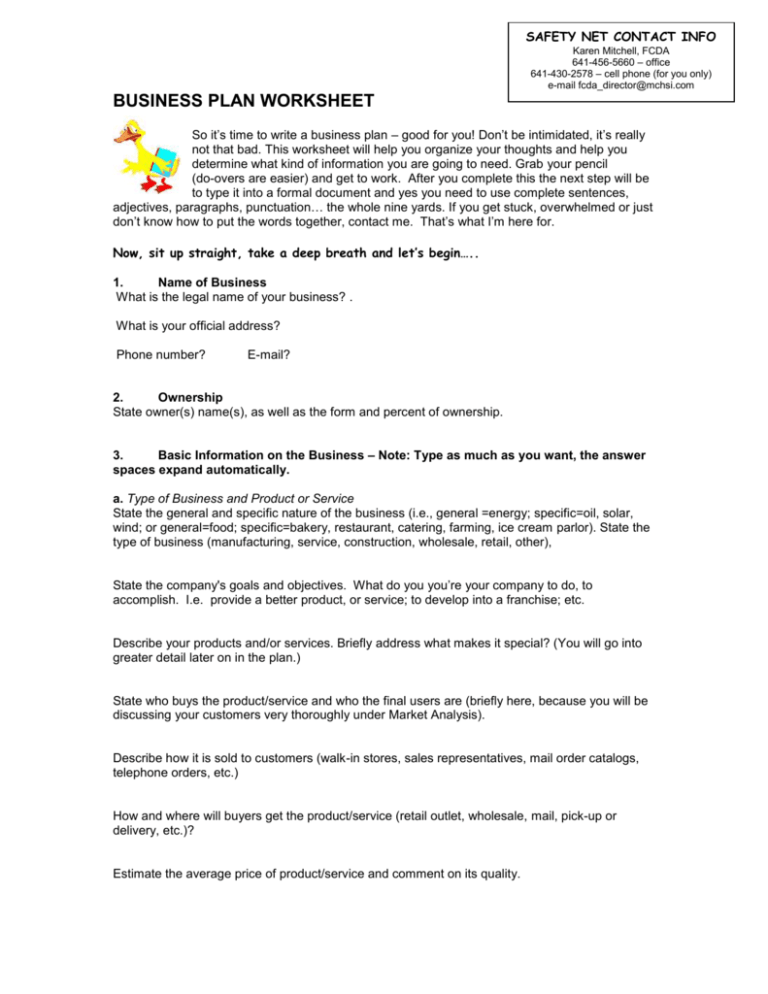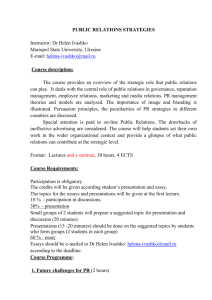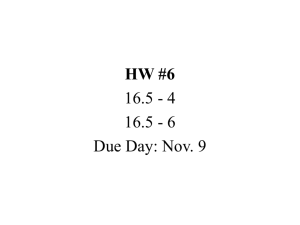Interactive Business Plan Worksheet
advertisement

SAFETY NET CONTACT INFO Karen Mitchell, FCDA 641-456-5660 – office 641-430-2578 – cell phone (for you only) e-mail fcda_director@mchsi.com BUSINESS PLAN WORKSHEET So it’s time to write a business plan – good for you! Don’t be intimidated, it’s really not that bad. This worksheet will help you organize your thoughts and help you determine what kind of information you are going to need. Grab your pencil (do-overs are easier) and get to work. After you complete this the next step will be to type it into a formal document and yes you need to use complete sentences, adjectives, paragraphs, punctuation… the whole nine yards. If you get stuck, overwhelmed or just don’t know how to put the words together, contact me. That’s what I’m here for. Now, sit up straight, take a deep breath and let’s begin….. 1. Name of Business What is the legal name of your business? . What is your official address? Phone number? E-mail? 2. Ownership State owner(s) name(s), as well as the form and percent of ownership. 3. Basic Information on the Business – Note: Type as much as you want, the answer spaces expand automatically. a. Type of Business and Product or Service State the general and specific nature of the business (i.e., general =energy; specific=oil, solar, wind; or general=food; specific=bakery, restaurant, catering, farming, ice cream parlor). State the type of business (manufacturing, service, construction, wholesale, retail, other), State the company's goals and objectives. What do you you’re your company to do, to accomplish. I.e. provide a better product, or service; to develop into a franchise; etc. Describe your products and/or services. Briefly address what makes it special? (You will go into greater detail later on in the plan.) State who buys the product/service and who the final users are (briefly here, because you will be discussing your customers very thoroughly under Market Analysis). Describe how it is sold to customers (walk-in stores, sales representatives, mail order catalogs, telephone orders, etc.) How and where will buyers get the product/service (retail outlet, wholesale, mail, pick-up or delivery, etc.)? Estimate the average price of product/service and comment on its quality. b. History If the business is new, say so. If existing, discuss age of business, prior owners, how acquired and how long you have operated, # of employees, image or reputation, last year's sales volume and profit and any significant events that have affected the company's development. c. Offices/Plant Give Addresses and description of area or building. State size (square footage). State whether rented, leased or owned. If rented or leased, state from whom and under what conditions. If you are buying, describe how you will purchase it and pay for it. Describe type of access to building (major roads, freeways, walking, parking, etc.). Is the location a good one that is convenient to customers? Will you be easy or hard to find? State business hours. d. Personnel For the present and future state: Number of employees, the type of labor (skilled, unskilled, etc.) Address any training you might do (on site or workforce training programs. Positions they may hold, i.e. part-time sales, full-time office, manager, custodial, etc. Sources of labor. Where will you go to get your workers? Will you consider hiring minorities and the handicapped? Will you advertise locally? Use Iowa Workforce Development job site? Comment on the quality of the staff. What characteristics will you expect e. Economic/Accounting Describe how this business makes money. State how prices are determined and by whom. What kind of financial records will you keep? Who will be in charge of that? How will you do it? Will you use a computer and appropriate software? Will you be using the services of an accountant? What will they do? f. Inventory Describe what inventory, raw materials, products and/or supplies the business uses (initial and continuing). List your suppliers - name, address, type and percent of supplies furnished, and length of time you have been buying from each, reliability and frequency of purchase. How easy or difficult is it to get necessary supplies? If it is difficult, how will you deal with changing costs? g. Legal State form of business (sole proprietorship, partnership, corporation) and status (already formed or in process of formation). State licensing requirements (type and licensing source) and status (not yet applied, applied and pending, obtained). likafdlandflkad State zoning requirements and status (verified, OK, rezoning), and state insurance requirements (type, source) & status. Have building codes been complied with? State any health code requirements. Describe lease, if any. Also describe any other laws and regulations that affect the business. Trademarks, patents, licenses and copyrights should be checked for legality. h. Future plans What are your plans for the future (maintain, expand, diversify, sell, etc.)? 4. Market Analysis This is important – don’t cheat this one. a. Customers (Market) What is your market, or, who are your customers (wholesalers, retailers, consumers, government, etc.)? Why does this market need your product/service? Why will this market want your product/service? Is your product/service a fad or continuing need; being phased out or created by new technology? List the characteristics of your average customers: age, location (market area), income/sales, sex, lifestyle (family or single), working, and other important information. The more you understand your market, the better you can sell to it. What do customers like and dislike about your product/service or business? Estimate the size of the market (in terms of number of customers). Estimate how much the total market will spend on this or similar products/service in the next year. How did you arrive at that estimate? Describe any market research you did. b. Environment Discuss any environmental factors (economic, legal, social or technological) that affect your market or product/service. Environmental factors are those that have no control, i.e., county growth, rising energy prices, etc. c. Competition Discuss your competition: number of competitors (direct and indirect), type of company (i.e., product or service), location, age, reputation, size (sales or customers), market share. If possible, estimate how much of your product/service all the competition will provide in the next year. List major competitors (names and addresses) and discuss their: product/service features, price, location/distribution, reputation/image, market share, size, age, product/service quality, and marketing strategy. If you have no direct competition, say so. d. Competitive Advantages and Disadvantages Discuss how your product/service meets market needs and how you compare with the competition in terms of product/service features, location/distribution, price, other. Compare your estimates of the market's demand and the competition's supply. The relationship of supply and demand will affect your marketing and sales strategy, i.e., high demand with low supply usually means less competition and less advertising. Conversely, low demand and high supply indicates a very competitive situation and a need for extensive marketing. e. Projections Give your projections in terms of the number of customers or items sold or contracts obtained, etc. Get back here, you’re doing great – let’s keep going! 5. Market Strategy a. Sales Strategy Present your marketing strategy. How are you going to sell your product? This is not how you will advertise your product, but how you will get the edge on your competition and get customers. This is your action plan to get business. Your product/service will sell because one or more of the following is attractive: features, pricing (high, medium or low), distribution system (limited, widespread, etc.), and promotion. Will this include internet sales? If so, how will you manage that? Who will be in charge? Take as much space as you need to answer this. b. Promotion Strategy Describe how you plan to promote your product/service. State how you will promote: advertising, direct mail, personal contacts, sponsoring events or other (word-of-mouth, trade associations). If you plan to advertise, state what media you will use: radio, television, newspaper, magazines, telephone book yellow pages, and/or other (billboard, etc.). State why you consider the media you have chosen to be the most effective. Take as much space as you need to answer this. State the content of your promotion or advertising: what your product/service is, why it is attractive, business location, business hours, business phone number, and other. When you are designing your advertising, remember you are selling to satisfy someone's need. Refer back to your Market Analysis on need. Take as much space as you need to answer this. 6. Management Yes, it will fall on you. Why have you chosen this type of business? For key management personnel, include the following: resumes, personal financial statements, tax returns for the last three years Describe prior experience that qualifies management to run this type of business. State why you feel you can run this business. State how much time management will devote to running this business. Discuss local contacts who may assist you in your business. 7. Financial a. Sources and Uses Describe the project to be financed. State where the money to pay for the project will come from (sources) and show in detail how it will be used (uses). The common uses are equipment, leasehold improvements, inventory, and working capital. Example: ITEM TO BE FINANCED COST SOURCE OF FUNDS Building/land $200,000 Loan from Bank Equipment (list specifics) Truck $40,000 FCDA Revolving Loan Grinder $15,000 Equity investment Shelving Inventory $ 25,000 Equity investment (your own money) Computers/Office Equipment $ 8,000 Loan from parents ITEM TO BE FINANCED COST b. Statements - Historical and Projected SOURCE OF FUNDS If the business is an existing one, include business tax returns and financial statements for the last 3 years. Financial statements should include: Balance Sheet Income Statement Accts. Receivable and Aging Debt Schedule Accts. Payable and Aging Reconciliation of Net Worth For both existing and new businesses, project the following financial statements for the next 3 yrs. (monthly for 1st year, annual for 2nd and 3rd): This can often be done using a computer program or an accountant. Operating (or Income) Statement with explanation (sales, expenses, profit) Balance Sheet Reconciliation of Net Worth Cash Flow with explanation Break-even Analysis – Best done by an accountant unless you are experienced in financials. 8. Summary Synopsize your business: the plan, why it will succeed, who you will sell to. A brief paragraph will do. Think of it as an elevator speech - a last sales pitch. CONGRATULATIONS YOU DID IT!






